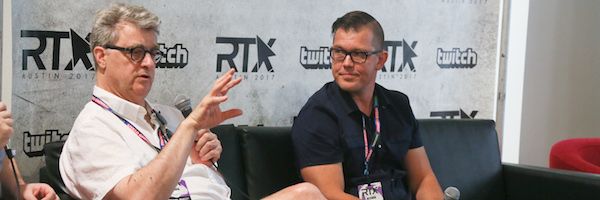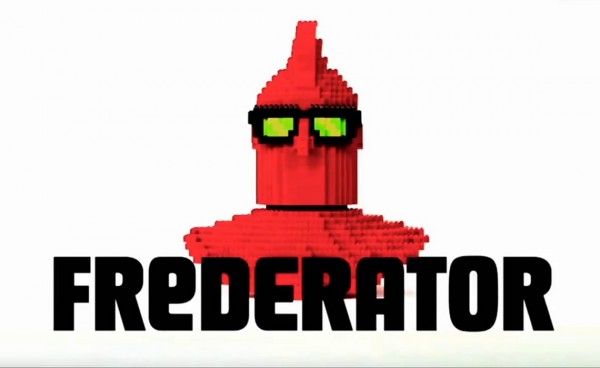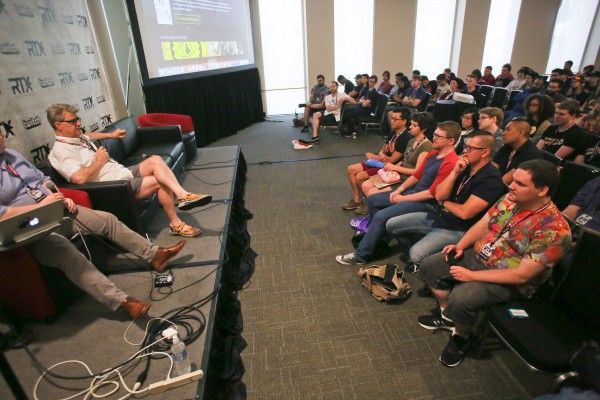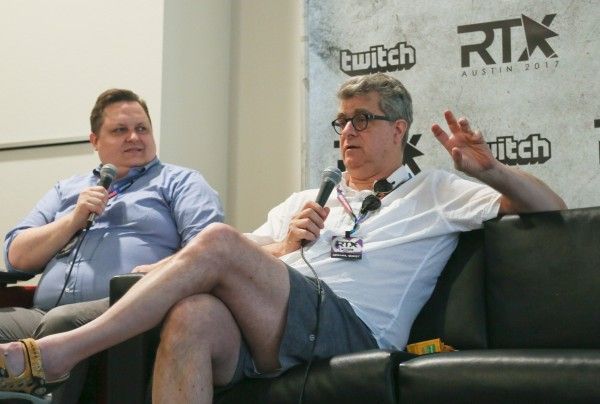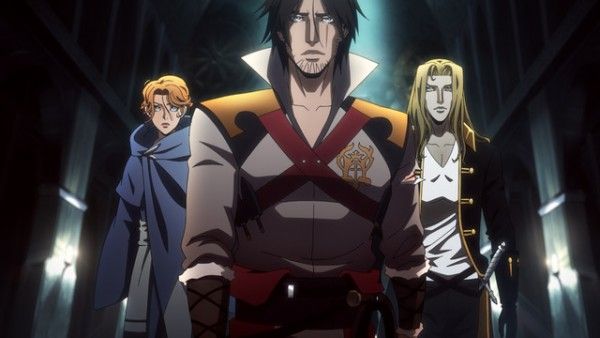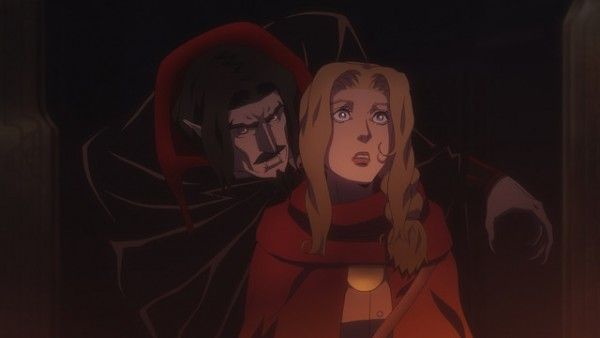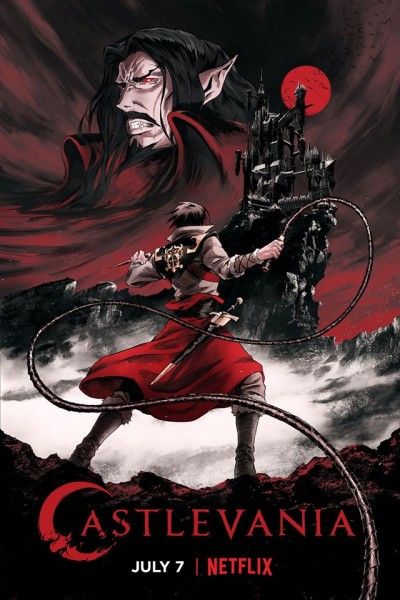During this past weekend's RTX 2017--Rooster Teeth's epic fan expo dedicated to movies, TV, video games, and all things Internet-related--I had the once-in-a-lifetime opportunity to chat with legendary producer Fred Seibert. If you've watched just about any super-popular cartoon over the last 25 years, there's a good chance Seibert had a hand in bringing it to your attention. After serving as MTV's first-ever creative director of MTV and taking Nickelodeon from worst to first among cable networks, Seibert entered the world of animation and has not looked back since. He's been instrumental in bringing shows like Dexter's Laboratory, The Fairly OddParents, Adventure Time, and Castlevania into the world.
It's mostly that latter show, the Netflix-streamed adaptation of the classic Konami video game franchise, that brought Seibert and his Frederator Studios banner to RTX 2017. Of course, in keeping with the studio's mantra of bringing exposure to voices and talents that wouldn't otherwise receive any, Seibert also brought some friends along for his "Fred and Friends" panel. We talked about his continuing career in animation production, the inspiration for the incubator model and its successes and failures, and titles like Castlevania and Costume Quest. (Keep an eye out for a future article which breaks down all of Frederator's upcoming projects.)
Rarely, if ever, have I ended an interview feeling so inspired, energized, and optimistic; I hope to convey some of those boons to you as you read on below:
From Seibert's time with major networks like Nickelodeon and Cartoon Network, to his continuing work bringing animation to audiences through the internet, one aspect of his approach has stayed constant:
Fred Seibert: Our shop was set up originally just to expose new talent. By definition, that’s a constantly replenishing stream. The thing that’s different now in the world is that instead of that new talent being focused only in Los Angeles, it literally has spread in an amazing way. We’re making cartoons with people from all around the world. I never expected that … The Internet opened up our ability to communicate. We’re about to wrap our first short from a Latvian animator. I don’t know about you, but who knew?
Another common thread seems to be that everything that Seibert touches turns to gold. When his name appears next to some of the biggest animated properties over the last 25 years, that's bound to be the assumption. But does Seibert actually have the animated equivalent of the Midas Touch?
Seibert: I have no sense of what’s going to take off. None. If I did, I’d be a magician. I came of the media world as a 12-year-old Beatles fan. They opened up the notion to me that you could make great art and be highly commercially successful simultaneously. Along the way, I always use that as a North Star of looking for things that thrilled us and had an original voice, and at the same time was one that everybody could enjoy. I come from Pop, I’m a Pop guy. I look for people who ring that inner ear. That being said, I have publicly and often said that I was the one in the shop who said “No” to Adventure Time. The truth is, luckily, I have surrounded myself with a team of people who feel free to bring things into the shop that wouldn’t necessarily fit the preconceptions that we have. We look at it as an article of faith to constantly be renewing our point of view about what is or isn’t right for Frederator. We’re kind of incapable of following trends, so often we help start trends.
Starting a trend that sticks is tough to do, but Seibert's incubator model of production has certainly been a successful way to find the diamonds in the rough without committing to full series runs from the getgo. However, Seibert's model had some surprising inspiration:
Seibert: I was always a huge fan of Motown in Detroit, where literally their incubator was a double house in a poor section of Detroit where, from the basement recording studio to the top floor, which was Berry Gordy’s office, the whole system happened inside of that house. They were accused over the years of having a mass-production system and that things turned out the same-y. Motown released every single that they recorded, and you go back and see how many failures they had, you see when they got to a point of success where the successes outweighed the failures, and back and forth. Going into the system, I literally copied Motown. How will we ensure our success? How will we expose these voices that haven’t gotten exposed before?
It really came down to economics. When I started in animation, literally knowing nothing, I’m 40 years old having never been in an animation studio let alone running one. I immediately thought my job was to make TV series, so I greenlight two series. In those days, that probably cost $5 million each. We work a year and half on each of them … and six weeks later, they’re dead. What do we do now?
I had this idea for this singles system, but that wasn’t the way the business worked. I went to my boss—and his boss, Ted Turner—saying, “If you could spot me another $10 million, I could make this work. If we try something 50 times, how stupid would I have to be for 1 of them not to work?” Ted Turner being an entrepreneur more than any other single thing, and certainly a risk-taker, that logic appealed to him.
Hanna-Barbera was a studio that hadn’t had a success in a long time but had a very, very potent name within the industry. We put out the word and said, “We’re interested in pitches from anyone.” We ended up with about 5,000 pitches, and our definition of a pitch was the storyboard for the show, not just an idea. You have to draw a storyboard, so you’re a filmmaker, and you have to put in the work. 5,000 people sent in storyboards. The result is that 4,950 weren’t picked. The downside is that you’re disappointing a lot of people who have done an incredible amount of work. The next downside is, of those 50, most of them will not work, even though you go into it with the feeling of, “Yes, this one could be it.”
We developed a system of hope and optimism. We’ve done 250 shorts over the years; most of them don’t happen. But I would say the great majority of the people who have done those films are the world class in the industry and the top veterans within the business.
Those first-timers who became animation veterans include names like Genndy Tartakovsky, Craig McCracken, Rob Renzetti, Butch Hartman, Seth MacFarlane, and John R. Dilworth. An impressive list, to be sure.
Of those 250 shorts, the first 99 were created by white men; the 100th was their first to be created by a woman. In the 150 shorts since then, more than a dozen have been created by women, as well as creators from Australia, Finland, Latvia, and many more places around the world. So in keeping with the theme of trendsetting, how does Frederator stay ahead of the curve both socially and technologically?
Seibert: There are two sides to how you stay ahead of the curve: One is, your own behavior. What are you hoping and wishing, out of the things you do in your life, that can’t be done because of limitations? You start looking for the other places to go to expand your own personal inclinations. Everything we do is based on the way that our colleagues all feel about something or other. We started doing eBooks because I was an early, early, early eBook reader because I love the idea of the convenience of eBooks; really as simple as that.
The other side of it is, you know the old phrase, “The pioneers are the ones with the arrows in their backs”? When I start something new, everybody is like, “Wow! Look at all these things you know!” And then all of a sudden they become good enough at it that they start telling you what to do. And I have a really thin skin and I don’t like people telling me what to do, so as soon as they do, I move on. One of the ways I got into animation was that I had been in television for 10 or 12 years and too many people were telling me what to do, so I became much less interested in the media side, the network-running side, and I got into production.
And then in production at a certain point you get too many people telling you what kind of productions to make. How can I get around these people? Oh, the Internet! So it’s not a matter of being ahead of the curve as much as my wanting to go into a space that is empty. We get to fail or succeed on our ability to make that empty space into something special.
The story of how Castlevania came to Frederator and how the show eventually came to Netflix is a tale that's 12 years in the making. The project was just the sort of thing that needed the perfect storm of available rights and technologies to get off the ground. Here's how Seibert describes his studio's working relationship with the streaming giant:
Seibert: They’ve been an unbelievable partner. You’ve probably heard that they keep their distance on creative stuff. I find it really interesting that they figured out a way to keep their distance but make the right choice. Immodestly, I say that coming into business with us was the right choice, but they seem to have, better than any of their brethren, figured out a way to choose people properly and give them enough room to succeed or fail on the terms that they developed. That’s how it’s been with us.
I would say that Frederator is the same way. The commonality between Adventure Time and The Fairly OddParents, well, they’re both funny, they both have a young boy at their center, they both were initially made for kids, but the major thing that’s the same is that there were creators with vision and we stayed out of the way of that vision. It’s an interesting marriage that way, between Netflix and Frederator, to be able to do that.
A missing piece of the Castlevania puzzle was the animation studio itself since the material was, admittedly, out of Frederator's wheelhouse:
[Producer and Castlevania rights-holder] Kevin [Kolde] was able to identify our partners here in Austin at Powerhouse, and it was the same thing: He had a vision, the script laid out a lot of that vision, he told them what it was that he imagined, and then the challenge was to stay back and let the creative team do the things that they do, which they did beautifully. At every single stage of this process have been people with vision, but light touch.
There are some real gems of inspiration and advice here won from the hard lessons learned by Seibert over his 30+ years of work in media and production. He handed out one more nugget of advice that seems just as beneficial in daily life as it does in animation: Keep your friends close, especially the ones who are more talented than you are. You never know when you'll be able to help them, or vice versa.
For more of my coverage from RTX 2017, be sure to keep an eye out for more articles later this week and check out my previously posted write-ups below:
- Don’t Sleep on ‘Day 5’, a Fresh, Thrilling Take on the Post-Apocalypse
- ‘RWBY’: Why You Should Be Watching Rooster Teeth’s Hit Anime Sensation
- ‘Castlevania’ Review: Netflix’s Video Game Adaptation Has Some Serious Bite

